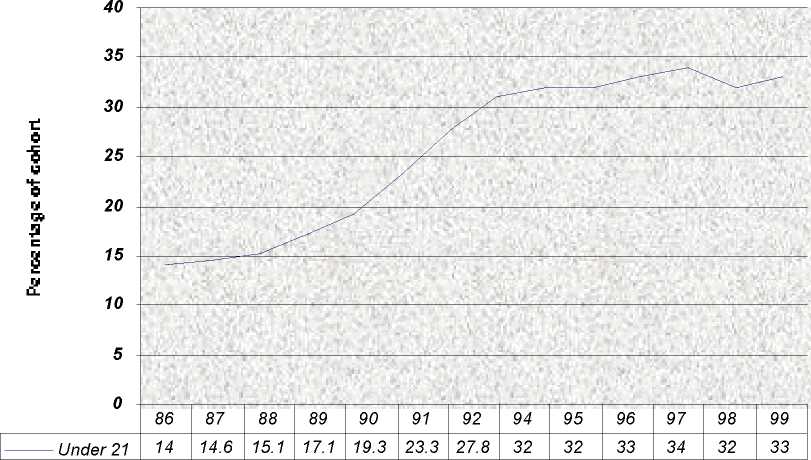Participation in higher education has grown dramatically in the last 30 years - from five per cent
of the 18-21 year old age group in the early 1960s to about 33 per cent in the late 1990s - with
the steepest climb being in the late 1980s and early 1990s (see Figure 5).
Figure 5: Participation in higher education by 18-21 year olds

Source: DfEE (1999) Departmental Report (Annex Q); HESA (2000) SFR 38
The expansion period, based mainly on the full-time participation of 18-21 year olds, brought
about important changes in the composition of higher education students. There was a dramatic
increase in the number of females involved in higher education - by 1996 they constituted 51 per
cent of participants compared to 26 per cent in 1962. (NCIHE 1997). Moreover, many ethnic
minority groups have become more than proportionately represented in higher education,
although the majority of these students are concentrated in the 1992 universities. However, there
has been a much slower change in the social composition of higher education. Despite the
doubling of the proportion of entrants from semi-skilled and unskilled socio-economic groups,
the general social composition of higher education remains largely unchanged (NCIHE 1997).
This may be allied to the fact that there has been much less change in the balance between full-
time and part-time students during the expansion period (HESA 1999).
More intriguing information
1. The name is absent2. The name is absent
3. THE DIGITAL DIVIDE: COMPUTER USE, BASIC SKILLS AND EMPLOYMENT
4. Happiness in Eastern Europe
5. The name is absent
6. The name is absent
7. Antidote Stocking at Hospitals in North Palestine
8. Une Gestion des ressources humaines à l'interface des organisations : vers une GRH territoriale ?
9. Ronald Patterson, Violinist; Brooks Smith, Pianist
10. The Determinants of Individual Trade Policy Preferences: International Survey Evidence